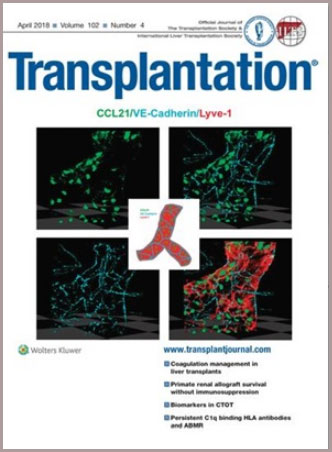
April Edition of Transplantation Journal
The April issue is crammed with great articles: AMR, biomarkers from CTOT, organ perfusion, and more. Lots to read!
Transplantation Journal - Cover Artwork Submissions!
Transplantation is now accepting authors’ artwork submissions for covers of the journal. Suitable content must be transplant related but does not need to relate to an accepted Transplantation paper. These standalone submissions should be unique, stunning, colorful images of very high resolution (1200 dpi). Authors are asked to submit an image with an extended figure legend discussing the image and its relevance to transplantation topics. References to previously published material are acceptable. There are no costs to publish these color images. Please see full guidelines in our Instructions to Authors. We look forward to your submission!
Transplantation Journal - Featured Article
Submitted by Dr Peri Kocabayoglu Editorial Fellow, Transplantation.
A Comparative Study of the Predictive Values of Urinary Acute Kidney Injury Markers Angiogenin and Kidney Injury Molecule 1 for the Outcomes of Kidney Allografts
Tavernier Q, Tinel C, Rabant M, Morin L, Anglicheau D, Pallet N.
Transplant Direct. 2017;3(9):e204
Biomarkers that may help predict outcomes after kidney transplantation remain to be investigated in clinical and preclinical studies and have not been established as clinical routine. Here, Tavernier et al measured urine levels of injury-related markers Kidney Injury Molecule-1 (KIM-1) as well as Aniogenin (ANG) in a cohort of 244 kidney transplant recipients 10 days after transplantation. Interestingly, although urinary ANG and KIM-1 levels correlated with cold ischemia time, delayed graft function and plasma creatinine, they did not predict graft survival, renal function and histological changes seen in protocol biopsies by 3 and 12 months. Further studies are needed in order to identify independent predictors of graft outcomes, especially biomarkers.
2nd Opinion Leaders Meeting on Stem Cell Derived Beta Cells | May 7-8, 2018 | Boston, MA, USA
REGISTRATION WILL REMAIN OPEN UNTIL FRIDAY, APRIL 13th - Onsite Registration Will Not Be Offered
REGISTER NOW AND SECURE A PLACE - THE WORKSHOP HAS LIMITED CAPACITY
In the News
Meet Your Interstitium, a Newfound "Organ"
March 27 - With all that's known about human anatomy, you wouldn't expect doctors to discover a new body part in this day and age. But now, researchers say they've done just that: They've found a network of fluid-filled spaces in tissue that hadn't been seen before.
Researchers discover new accuracies in cancer-fighting, nano drug delivery
March 21 - A promising discovery for advanced cancer therapy reveals that the efficiency of drug delivery in DNA nanostructures depends on their shapes, say researchers at Missouri University of Science and Technology and the University of Kansas in a scientific paper published today (March 21, 2018).
Netherlands, China to cooperate in promoting 'hot' transplantation
March 26 - Hospitals from the Netherlands and China have signed a cooperation deal to develop a groundbreaking organ transplantation method and expand it worldwide.
Human tests for lung transplant drug almost ready
March 26 - The University of Virginia Medical Center will soon be testing a drug on humans for the first time to help reduce or prevent lung injuries after transplant surgery.
Sex differences influence organ transplant rejection rate
March 22 - Men and women who receive donated organs can have different rates of transplant rejection, in some cases influenced by the sex of the donor, according to a new study by investigators at Brigham and Women's Hospital (BWH).
Treatment with Hepatitis C Antivirals Improves Outcomes Following Liver Transplantation
March 22 - Although oral antiviral agents have improved liver function in patients with hepatitis C virus (HCV) infection, the relationship between their use and outcomes for patients on liver transplant waiting lists or for those who underwent liver transplant has been unconfirmed.
World's First Commercial iPSC Cell Plant Opens in Japan
March 23 - A pharmaceutical company based in Osaka, Japan, opened a regenerative medicine center yesterday (March 22) that will produce cells derived from induced pluripotent stem (iPS) cells for commercial applications. The center is the first plant of its kind globally. It will initially produce cells for use in clinical trials.
Trained navigators may improve access to transplantation for disadvantaged patients
March 26 - In a recent study, a trained navigator who provided guidance to disadvantaged patients with kidney failure helped increase access to the transplant waitlist among patients who needed a longer time to get through the transplant evaluation process.
Contact
Address
The Transplantation Society
International Headquarters
740 Notre-Dame Ouest
Suite 1245
Montréal, QC, H3C 3X6
Canada
Используйте Вавада казино для игры с бонусом — активируйте промокод и начните выигрывать уже сегодня!




